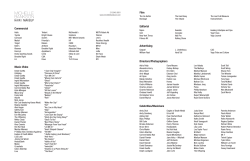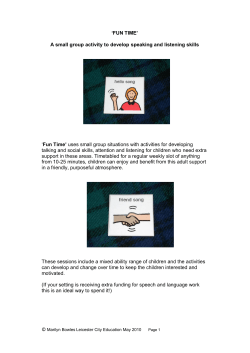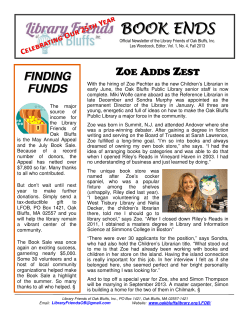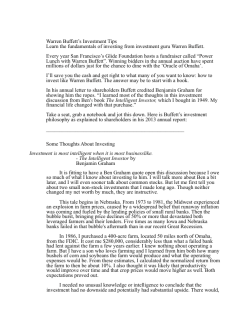
Marilyn monroe I ‘Being Marilyn’ 56
56 Marilyn monroe ‘Being Marilyn’ Norma Jeane Mortensen Baker (June 1, 1926 – August 5, 1962) by Danielle Wiersema In 2012 it will be 50 years since the death of Marilyn Monroe, the world’s quintessential sex icon. Many have investigated the profound impact she still has all these years later, with her irresistible mix of vulnerability and sensuality. But what is the secret behind the magnetism she radiated in life and on screen, what has made her playful sexuality so inspiring to women for the last 5 decades? More importantly, what did that sexual power bring her in the end? The answers might be hidden inside her own words. Drawing from two sources, her memoir ‘My Story’ and the numerous notebooks she kept, collected in the 2010 publication ‘Fragments’, this article tries to shed some light on the shy girl by the name of Norma Jeane Mortensen and her creation of the iconic Marilyn Monroe. BIOGRAPHY In Her Own Words The memoir My Story, published posthumously in 1974 by Marilyn’s friend, photographer Milton H. Greene, and ghost-written by the famous screenwriter Ben Hecht, is a collection of candid childhood memories and thoughts on life, love and men. Although written by Hecht over the course of several months in 1953-1954 in which they met on a regular basis, Marilyn’s voice is very discernible from the pages. Whether or not the subject is painful, her sense of humor and determination is clear throughout the book, especially in the irony with which she describes the film industry. Her honesty is refreshing and definitely in character as only years before she confessed posing for nude pictures and not being an orphan, as the studio’s PR department had communicated. However, one cannot escape the feeling that Marilyn was very aware of her public image while working on the book, posing as an innocent, hardworking and fun-loving girl. The book ends around the time of her marriage to Joe DiMaggio, unfinished because of her busy schedule.1 Throughout her life Marilyn scribbled thoughts, observations and poems as well as recipes and ‘to do’ lists in numerous diaries and notebooks, on torn out pages and hotel stationary. The style is often stream-of-consciousness, the associative and sometimes erratic mind wanderings of the movie star in a pensive or depressed mood. These documents were filed in two boxes, the contents of which were only discovered some years ago.2 Now collected in the book Fragments, we are able to explore her very private thoughts. The Marilyn in Fragments is a very different person from the funny and feisty heroin from My Story. The woman who emerges from these pages is very vulnerable, often feeling lost and overwhelmed by her fame, yet at the same time extremely determined to 1 Florice Whyte Kovan, A Ghost Materilized, Ben Hecht Finally Credited on Marilyn Monroe’s Memoir’s (article in the Ben Hecht Story & News, ISBN 16290811 Volume 3, Number 1, 2001) www.benhechtbooks.net/ben_hecht__marilyn_monroe 2 Sam Kashner, Marilyn and her monsters (article in Vanity Fair, Condé Nast International, November 2010). 58 better herself, exploring the traumas of her past and making resolutions on how best to tackle her inner demons. The difference between the public persona of the beguiling Marilyn Monroe and insecure Norma Jeane could not have been greater. Little Girl Lost Norma Jeane Mortensen was born on June 1, 1926. Her mother Gladys Monroe Baker was a single woman, working as a cutter at one of the film studios in Hollywood. As a divorcee who had already abandoned two children with her first husband, Gladys was living the good life in the roaring twenties, dating several men, one of whom fathered Norma Jeane. The little girl never knew her father, although later in life she claimed to have found out who he was. Two weeks after her birth, Gladys left Norma Jeane in the care of a family whom she paid $ 5 per week to take care her.. Gladys’ family had a history of severe mental illness and she was soon to be hospitalized in psychiatric facilities for long stretches of time. Norma Jeane grew up a lonely, shy and subservient girl in a string of foster families and orphanage homes, always lacking food, clothing and love. Seemingly without bitterness, there is even a hint of proud defiance when she sums up her early childhood in My Story: ”The people I had thought were my parents had children of their own. They weren’t mean. They were just poor. They didn’t BIOGRAPHY have much to give anybody, even their own children. And there was nothing left over for me. I was seven, but I did my share of the work. I washed floors and dishes and ran errands.” 3 She was a sweet and dreamy child, often fantasizing about a loving father figure coming to take her away. Always the outsider, men were instinctively drawn to her vulnerability and she was soon to be preyed upon. When she was only eight years old one of the boarders in her foster home sexually abused her in his room. Aunt Ida, her foster mother at that time, didn’t believe her and even scolded her for accusing her ‘star boarder’. A very devout and strict woman, she would imbue the young girl with fear and shame about ry: ”… and the immediate fear of any part of my body there – fear to touch my own body after Buddy (I started to write Bad instead of Buddy – slip in writing?) because A.I. [Aunt Ida] punished me with fear and whipped me – “the bad part of my body” she said – must never touch myself there or let anyone – wash cloth – water running from it fear wonderment the wondering of something ask it questions – the unbelievableness of the actually [sic] if it happened.”4 her body and sexuality. Around 1955-56, when Marilyn started psychoanalysis, she recounts her feelings after the rape in her notebook. Her wry sense of humor when she discovers a ‘slip of the pen’ coming out even in what is obviously a painful memo- small, all of a sudden boys noticed her: “The school and the day became different after that. Girls who had brothers began inviting me to their homes, and I met their folks, too.”5 Although most girls treated 3 Marilyn Monroe with Ben Hecht, My story (Taylor Trade Publishing, 2007) p. 1 Teenage Marriage Norma Jeane’s body developed early and as a twelve year old she already had the curves of a grown woman. In My story she recalls one day wearing one of her foster sisters’ sweaters, which was a size too 4 Marilyn Monroe, Ik ben alleen (Meulenhoff, 2010) p. 125 5 Marilyn Monroe with Ben Hecht, My story (Taylor Trade Publishing, 2007) p. 23. 60 her with hostility, jealous of the attention she got, Norma Jeane didn’t mind. Being nicknamed ‘the mouse’ for her shyness, good or bad, she now revelled in the attention. She even started experimenting with make-up and practiced walking seductively. Something that would be useful later in life when she transformed into Marilyn Monroe. The punishment of Aunt Ida had proven to be very effective because her newfound sensuality which in fact wasn’t sexual in nature: “There were no thoughts of sex in my head. I didn’t want to be kissed, and I didn’t dream of being seduced by a duke or a movie star. The truth was that with all my lipstick and mascara and precocious curves, I was as unsensual as a fossil. But I seemed to affect people quite otherwise.”6 While Marilyn professed to be ‘unsensual’, she did enjoy the effect she had on boys. She had a string of suitors who would take her out, hoping for a kiss. By now she was living with her legal guardian Grace McKee-Goddard and her husband ‘Doc’. 6 Ibid p. 26 Norma Jeane would have been sent back into foster care after Doc raped her when he was drunk.7 Instead, at sixteen Grace married her off to James (Jim) Dougherty, the twenty-one year old son of her neighbor, so that until Norma Jeane became legally an adult, she wouldn’t have to go back to an orphanage. The marriage was not a happy match. After Jim was sent off to war in 1944, Marilyn, like many other women, took a job in a factory where a visiting army photographer eventually discovered her as a model. Although the increased work participation of women and their subsequent financial autonomy slightly blended the lines between men’s and women’s societies, the dominant male view of women was not so easily transformed. This is evident in the huge popularity of the stereotypical pin up photography and artwork of which Marilyn did her fair share. When Jim came back after two years of fighting in the South Pacific, the unlikely couple were estranged and they split up. 7 Adam Victor, Marilyn Monroe Encyclopedie (Könemann Verlagsgesellschaft mbH, 2000) p. 123 BIOGRAPHY The End of Norma Jeane Norma Jeane, divorced at nineteen, moved into a tiny room in Hollywood, trying to find work as a model to pay the rent. Without any friends or relatives in the world, she desperately wandered the streets of Los Angeles, often going to Union Station (the Los Angeles train station) just to be among other people. In her journal she wrote: “Alone!!!!! I am alone – I am always alone no matter what.”8 The utter sadness of these words is devastating. As a little girl, Norma Jeane grew up with the idols of the silver screen, dreaming of one day becoming an actress. To one as depraved of love and attention as she, the idea of recognition and adoration must have been magnetic. But in the big swell of wannabe actors and actresses she was just another girl trying to get into the movies. So she spent the money she earned as a model on speech lessons, dance and acting classes. She went to auditions and parties, watching the movie stars present, all the time honing her acting skills: “I was young, blonde and curvaceous, and I had learned to talk huskily like Marlene Dietrich and to walk a little wantonly and to bring 8 Marilyn Monroe, Ik ben alleen (Meulenhoff, 2010) p. 57 9 Marilyn Monroe with Ben Hecht, My story (Taylor Trade Publishing, 2007) pp. 55. “I was young, blonde and curvaceous, and I had learned to talk huskily like Marlene Dietrich” emotion into my eyes when I wanted to. And though these achievements landed me no job they brought a lot of wolves whistling at my heels.”9 The wolves of course being men. Around the time she was finally cast as 62 a ‘bit-player’ in Scudda Hoo, Scudda Hay in 1948 (ironically, her bit was cut out of the movie), she had already changed her name to Marilyn Monroe, adopting her mother’s maiden name: “When I just wrote “this is the end of Norma Jean [sic],” I blushed as if I had been caught in a lie. Because this sad, bitter child who grew up too fast is hardly ever out of my heart. With success all around me, I can still feel her frightened eyes looking out of mine. She keeps saying, “I never lived, I was never loved,” and often I get confused and think it’s I who am saying it.”10 Here, Marilyn perfectly voiced her confusion about the Jekyll and Hide situation she had created for herself. The roles were completely reversed: instead of being Norma Jeane, she now identified herself completely with Marilyn, even getting confused about whether it was Norma Jeane or Marilyn who was saying these things. The Success of Being Marilyn Monroe In the following years Marilyn persevered 10 Ibid p. 32. in trying to break through as an actress. Although the studios didn’t really see her potential, her seductive screen presence wowed the audience. Their obvious appreciation of the sexy blonde already forebode the immense success she was to have later in her career: “I’d been on the screen in The Asphalt Jungle, and audiences had whistled at me – just as the wolves on the beach had done the first time I’d worn a bathing suit.” 11 The recognition she got from her small part in The Asphalt Jungle opened doors to other, more important casting directors and over the years she managed to land bigger parts in better movies, eventually starring as lead actress in blockbusters like Gentlemen Prefer Blondes, How to Marry a Millionaire and River of No Return. Her fame had a dual quality to it and she realized this very well: “In fact my popularity seemed almost entirely a masculine phenomenon. The women either pretended that I amused them or came right out, with no pretence, that I ir- 11 Ibid p. 67. BIOGRAPHY ritated them.”12 Her marriage in January 1954 to the legendary New York Yankees baseball player Joe DiMaggio propelled her already considerable fame to new heights. They were madly in love and were at that time the most glamorous couple on earth. Unfortunately, DiMaggio wasn’t too happy with the fact that his wife was every man’s dream. His jealousy steadily corroded their marriage. Marilyn’s decision to perform for the American troops in Korea during a publicity trip to Japan in honor of DiMaggio only deepened the rift that had already appeared. The final straw was the New York filming of the famous scene from the movie The Seven Year Itch in which Marilyn’s white dress flies up in a gust of wind, revealing her legs to the world and the hundreds of spectators in the street. The next day, when Marilyn showed up for work, her back was bruised from the beating she had taken from her husband.13 She filed for divorce after eight months and thirteen days 12 Ibid p. 159. 13 Adam Victor, Marilyn Monroe Encyclopedie (Könemann Verlagsgesellschaft mbH, 2000) p. 79 of marriage. Who Am I? For 6 years Marilyn had worked very hard to get to the top of her profession. But now, saddened and exhausted from the aftermath of her divorce, the pressure of being Marilyn Monroe was starting to get to her. Her studio, Twentieth Century Fox, was more than happy to typecast her invariably as the sexy but shallow blonde bombshell. Marilyn had other plans though. She wanted to be taken seriously as an actress and branch out to roles with more emotional depth. In 1955 she moved to New York and started classes in Method Acting at the famous Actors Studio of Lee Strasberg. Strasberg became an important mentor and father figure to her. He encouraged his students to go into psychoanalysis to ‘unlock’ their emotional potential. Psychoanalysis proved to be very painful for Marilyn and the classes with talented fellow actors like Marlon Brando made her very insecure about her own abilities. Despite her lack of confidence she had a fierce de- 64 termination to master the art of acting and get rid of her demons from the past. In her diary she wrote: “Ida [Aunt Ida] – I have still been obeying her – it’s not only harmful for me to do so (inhibits myself inhibits my work inhibits thoughts) but unreality [sic] because in my work I don’t want to obey her any longer and I can do my work as fully as I wish since as a small child intact first desire was to be an actress and I spend years play acting until I had jobs…I will not be punished or trying to hide it enjoying myself as fully as I wish or want to I will be as sensitive as I am – without being ashamed of it working (doing my tasks that I have set for myself) on the stage – I will not be punished for it or be whipped or be threatened or not be loved or sent to hell to burn with bad people feeling that I am also bad or be afraid or ashamed of my genitals being exposed known and seen so what! or colors or screaming or doing nothing or ashamed of my sensitive feelings – they are realality [sic] and I do have feelings very strongly sexed feeling since a small child – (think of all the things I felt then”14 While unlocking her emotional potential, Marilyn opened the door to all the anxiety and shame about her past, the feelings that for the last six grueling years she had pushed away. She tried to come to terms with these feelings and often made resolutions like the one above to not be affected by her past any longer. However, the traumas were too big to be tackled alone and Marilyn grew very dependent on a number of psychotherapists. Her neediness for consolation and advice was almost without limit and the boundaries in doctor-patient relations were often crossed. It came to the point where Marilyn couldn’t function properly without their daily guidance. The Great Escape The healing integration of Norma Jeane into Marilyn Monroe was under way, although modern day psychologists now 14 Marilyn Monroe, Ik ben alleen (Meulenhoff, 2010) p. 79 BIOGRAPHY “Help Help Help I feel life coming closer when all I want is to die” question the effectiveness of extensive psychotherapy. Her understanding of her coping mechanisms made her distinguish more and more between the two sides of her character: the shy girl and the assertive blonde bombshell. Marilyn’s need for acceptance of who she really was and her longing for love finally seemed to be fulfilled when she and playwright Henry Miller fell in love. The couple doted on each other, Miller being the intellectually superior and successful older man, and Marilyn affectionately calling him ‘daddy’. She was keen to start a family, believing that in becoming a mother she could escape her public life as Marilyn Monroe. But weeks after they got married in 1956 Marilyn stumbled across his diary, reading that Miller had serious doubts about their marriage and the effect it might have on his creative skills as a playwright. In fact, Miller was already experiencing a ‘dry spell’ in creative output for some years.15 Feeling betrayed, Marilyn wrote the following poem in her diary: “Help Help Help I feel life coming closer When all I want Is to die”16 She desperately tried to close the growing gap between them, only resulting in clingy and dependent behavior, which befuddled and irritated Miller. The effervescent Marilyn he had married, turned out to be traumatized Norma Jeane. Two miscarriages and one alleged suicide attempt later, the couple struggled on, living separate lives under the same roof. Feeling lonely, she had an affair with leading man Yves Montand while filming Let’s Make 15 Adam Victor, Marilyn Monroe Encyclopedie (Könemann Verlagsgesellschaft mbH, 2000) p.196 16 Marilyn Monroe, Ik ben alleen (Meulenhoff, 2010) p. 163 66 Love, which further worsened their already icy rapport. Finally, during the filming of The Misfits, which Miller wrote especially for Marilyn and the troubled production of which diminished his already frail self-confidence as a writer, their open hostility and fighting came to a head and they filed for divorce. The End Five years of extensive psychotherapy and another broken heart had passed and what did Marilyn have to show for it? She moved back to Los Angeles and tried to pick up the pieces of her life. Suffering from loneliness, chronic depression and a serious addiction to sleeping pills, uppers and anxiety pills, she was talking to her psychiatrist Dr. Ralph Greenson on a daily basis. She had affairs with high profile men, none of which lasted or brought her the love she longed for. To her friend and confidante Paula Strasberg (wife of Lee Strasberg) she wrote: “… Oh Paula I wish I knew why I am so anguished. I think maybe I’m crazy like all the other members of my family were, when I was sick I was sure I was. I’m so glad that you are with me here!”17 On her 35th birthday her old friend photographer André de Dienes went to visit her. He wrote in his memoirs that the movie star was very depressed. “But I observed that while she was talking, she became more and more downcast, bitter and sad. She let herself go, telling me the bad things life had dealt her. She said people were swindling her and treated her rotten. She looked so lovely, but so sad also, as she stood near the usual large pile of suitcases, everything all packed for her return to New York… I was thinking, what an amazing contrast, this meeting with her compared to when we had first met a little over fifteen years before. Now my darling little Norma Jeane’s soul was very worn out.”18 Sadly for his ‘darling little Norma Jeane’, even while she confided in her friend, he could not resist making a pass at Marilyn Monroe. “I saw the bed in the adjoining room, uncovered, so I began hugging her, kissing her, like old 17 Ibid p. 215 18 André de Dienes, Marilyn (Taschen, 2004) p. 219 BIOGRAPHY times in years before, and I suggested we should make love because it would make her feel better.”19 She refused him and he left. It was the last time he would see her alive. A year later, on August 5 1962, she died of a lethal dose of sleeping pills, presumably suicide. 19 Ibid p. 220 The Gilded Cage Shy Norma Jeane had created Marilyn Monroe. To great effect, all of Norma Jeane’s yearning for love and belonging came out of Marilyn’s eyes. The seductive looks and movements that she had practiced at home in front of the mirror mesmerized audiences all over the world. It was a part she played 68 with the confinement of her creation, tried again and again to break out of the mold, always hoping for a better future. It’s tragic that she never lived to see that day. very well, switching between ‘the mouse’ and the sexual icon at will. But it was also a gilded cage, the expectations and demands of the movie industry and the audience leaving no room for Norma Jeane. Men were attracted to her signature combination of vulnerability and sex appeal. In the end, they all wanted Marilyn, none of them chose Norma Jeane. This sweet and sensitive woman, constantly confronted My Story Marilyn Monroe with Ben Hecht ............................................... Encouraged by her friend, photographer Milton Greene, Marilyn openly recounted memories of her childhood and adolescence, her first steps towards fame and her courtship with Joe DiMaggio in several meetings to Oscar-winning screenwriter Ben Hecht. Written at the height of her fame, the book was not published because of disputes that arose between Hecht and literary agent Jacques Chambrun regarding the unauthorized publication of several chapters in London’s Empire News. Hecht backed out of the engagement and demanded that the manuscript be destroyed, wanting nothing to do with it ever again. Marilyn was apprehensive to publish, probably because of DiMaggio’s embarrassment at her straightforwardness through- BIOGRAPHY out the text. Ten years later however, the manuscript surfaced again when Milton Green sold it to the publishing house Stein and Day for $25.000, claiming that Marilyn gave him the manuscript. My Story was published in 1974, but with no credits to its real writer- Ben Hecht. It was only in 2000, when Cooper Square Press reprinted the book, that Hecht was finally credited as a contributor. Publisher: Taylor Trade Publishing (September 29, 2006) Fragments Marilyn Monroe ........................................ When she died, Marilyn left her personal effects to her mentor Lee Strasberg. To date, the Strasberg family licenses the image of Marilyn, which brings in millions of dollars per year for the main beneficiary of her legacy: the Lee Strasberg Theatre and Film Institute in New York. After Strasberg’s death in 1982, his third wife Anna Mizrahi-Strasberg auctioned off many of Marilyn’s personal belongings, picking up $13.4 million at Christie’s. Among Marilyn’s items were two boxes containing her personal diaries, poems and letters, which Anna, thankfully, arranged to be published. The book is organized chronologically and the original documents are printed facsimile, thus giving the reader a rare view of Marilyn’s own handwriting. A myriad of emotions is reflected in her notes: curiosity, wit, hope, desperation and sadness. While these ‘notes to self’ were never meant for publication, the publishers have succeeded in creating a 70 book that is as intimate as it is respectful. Understanding Marilyn through her notes ultimately means mourning her loss to the world anew. Publisher: Farrar, Straus and Giroux; First Edition edition (October 12, 2010) DANIËLLE WIERSEMA has a propaedeutic diploma in English and a master degree in communication science at the University of Amsterdam and has taken courses in journalism and in writing short stories at the Schrijversvakschool. Initially starting out in advertising she is currently working as a marketing manager at a magazine publishing house. As a freelance writer she finds the topics closest to her heart are history, literature, biographies and memoires, art and photography.
© Copyright 2025















